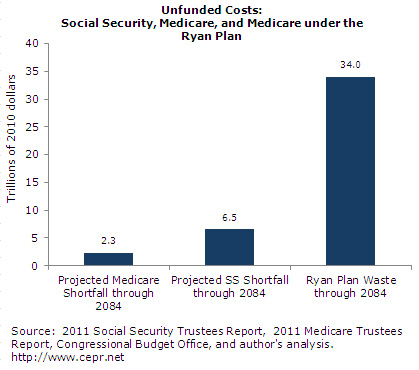May 13, 2011
May 13, 2011 (Social Security Byte)
By Dean Baker
Social Security projected to run a surplus of $69 billion in 2011.
The 2011 Social Security trustees report is far more optimistic about life expectancy than last year’s report. It projects that men who turned age 65 in 2010 can expect to live another 18.6 years compared with the 18.1 figure projected in last year’s report. Life expectancy for women at age 65 was projected at 20.7 years in the 2011 report, compared with 20.4 years in the 2010 report.
This assumed increase in life expectancy is the largest factor in a projected deterioration in the program’s finances. The shortfall expressed as a share of payroll over the program’s planning horizon is 2.22 percent, compared with 1.92 percent in the 2010 report. Expressed in dollar terms, the projected shortfall over the 75-year planning horizon is $6.5 trillion or 0.7 percent of GDP.
By comparison, the projected shortfall in the Medicare program is equal to 0.25 percent of GDP over the program’s planning period or $2.3 trillion. The Congressional Budget Office’s assessment of the Ryan plan endorsed by the GOP implied that it would increase the cost to the country of buying Medicare-equivalent policies by more than $34 trillion over the program’s 75-year planning period, in addition to transferring $5 trillion in costs from the government to seniors.

It is interesting to note that while the Social Security Trustees assume a big jump in life expectancies for retirees today compared with their assessment last year, they actually assume less progress in future decades. The 2010 Trustees report assumed that between 2010 and 2080, life expectancy at age 65 for men would increase by 4.2 years and by 4.1 years for women. By comparison, the 2011 report assumes an increase in life expectancy over this period of just 4.0 years for men and 3.9 years for women.
By having more improvement in life expectancy now and less in later years, the near-term finances of both Social Security and Medicare look somewhat worse. The date at which Social Security is first projected to face a shortfall is 2036 in this report compared with 2037 in last year’s report. Medicare is first projected to face a shortfall in 2024 in this year’s report as compared to 2029 in last year’s report, even though the shortfall expressed as a share of payroll increased by just 0.13 percentage point.
At present, both programs are still running annual surpluses. Social Security is projected to run a surplus of $69.3 billion for 2011 as interest plus dedicated taxes exceeds benefit payments. This includes $105.4 billion that is being credited to the trust fund from general revenue to offset the lost revenue from the temporary payroll tax cut of 2010. It is projected to remain in surplus until 2025 when it is first projected to start selling off bonds held by the trust fund.
While this accounting should be fairly straightforward (Social Security has income from both tax revenue and assets, like other pension funds) there has been considerable confusion in the media on this issue. It has often been asserted that the government is borrowing to pay the interest or the principle on the bonds held by Social Security. In fact, the money owed to Social Security is already part of the government’s debt, as can be seen by the debate over raising the current $14.3 trillion debt ceiling. That figure includes more than $2.6 trillion in bonds held by the Social Security trust fund.
When the Social Security program uses either the interest or principle from these bonds to pay benefits, from the standpoint of the government’s debt, it is the same thing as if any other bondholder opted to sell bonds to pay for their expenses. The total amount that the government has borrowed by changing the identity of the bondholder remains the same.
The main change in this report from last year’s is the assumption that current retirees and those retiring in the near future will enjoy longer life expectancies, although progress will be slower in future decades. While the assumption of longer life expectancies does raise the cost of Social Security and Medicare, the projected shortfalls in both programs are still relatively modest. Measured as a share of GDP, the combined shortfalls are roughly half the increase in the share of GDP devoted to military spending between 2000 and 2011.
CEPR’s Social Security Byte is an analysis of the 2011 Social Security Trustees Report.






